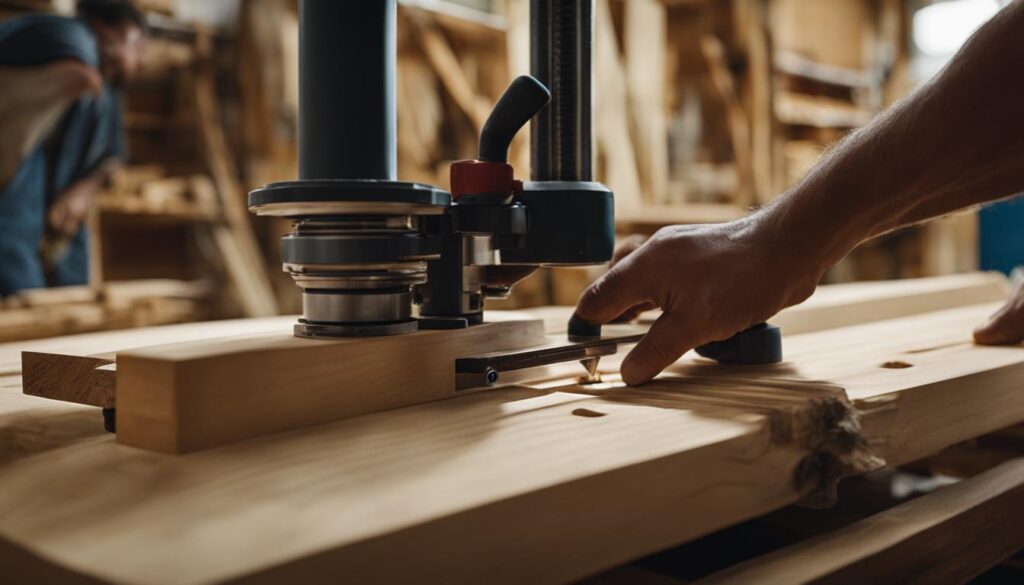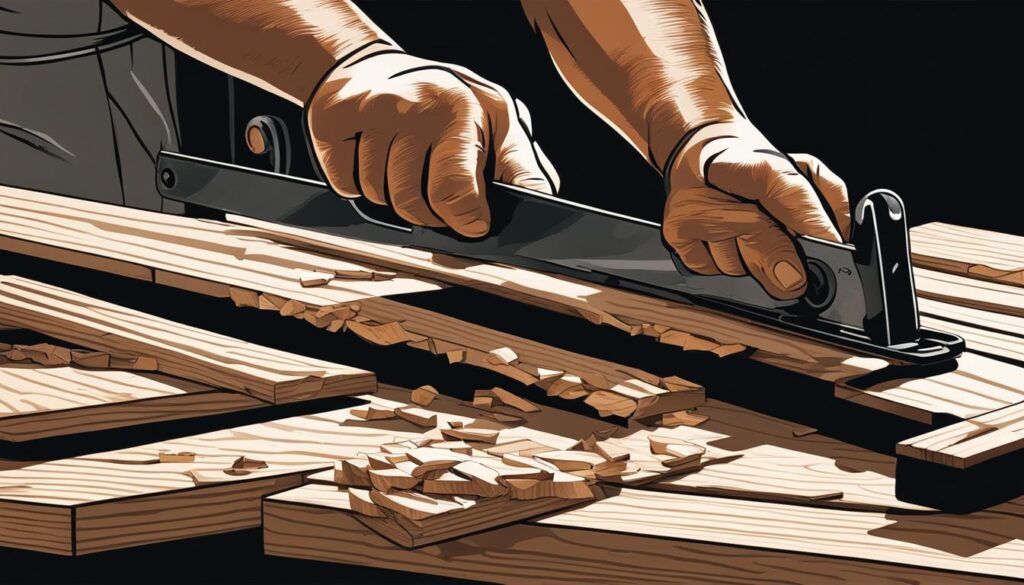We may earn money or products from the companies mentioned in this post.
If you are a woodworker looking to elevate your craft, mastering router woodworking skills is essential. The router is a versatile tool that allows for intricate designs and precise cuts, making it a valuable addition to any workshop. In this section, we will explore the different techniques, projects, and tips that can help both beginners and advanced woodworkers improve their craft using a router.
Key Takeaways
- Router woodworking skills can take your woodworking projects to the next level.
- There are different techniques and tips to master router woodworking skills for beginners and advanced woodworkers.
- Router woodworking allows the creation of intricate designs that can add a unique touch to your projects.
- Efficient woodworking saves time and improves the overall quality of your projects.
- Various resources such as books, online tutorials, and communities are available for further enhancing router woodworking skills.
Understanding the Basics of Router Woodworking
Router woodworking is an essential skill for anyone looking to create professional-grade projects. However, before jumping into advanced techniques, it’s crucial to understand the basics. This section will cover the fundamental concepts, safety guidelines, and essential tools needed for successful router woodworking projects.
The Router
The router is a versatile tool that can shape edges, cut joinery, and create intricate designs. It works by spinning a router bit at high speeds, which removes wood as it moves across the workpiece. There are two main types of routers: fixed-base and plunge-base.
The fixed-base router is ideal for edge profiling and cutting dadoes, while the plunge-base router is better for making deeper cuts and working with templates. Both types of routers are useful for beginner router woodworking projects.
Safety Guidelines
Router woodworking can be dangerous if proper safety precautions are not taken. Always wear eye and ear protection and avoid loose clothing or jewelry that could get caught in the router. Additionally, never start the router with the bit in contact with the workpiece, and always hold the router with both hands.
It’s also crucial to keep the router bits sharp and clean, as dull bits can cause tear-out and create unsafe working conditions. Always unplug the router before changing bits or making adjustments.
Essential Tools
In addition to the router, several other tools are necessary for successful beginner router woodworking projects. These include:
- Router bits: There are a variety of router bits available that can shape edges, cut joinery, and create decorative designs. Beginners should start with a few basic bits, such as a straight bit and a round-over bit, and gradually expand their collection as needed.
- Router table: A router table provides a stable platform for the router and allows for more precise cuts. It also frees up both hands to guide the workpiece across the bit.
- Jigs and templates: Jigs and templates are useful for creating repeatable cuts and shapes. They can be made from scrap wood and are essential for creating precise dovetails, box joints, and other joinery.
By understanding the basics of router woodworking, including the router itself, safety guidelines, and essential tools, beginners can start honing their skills and creating impressive projects.
Exploring Advanced Router Woodworking Techniques
Once you have mastered the basics of router woodworking, it’s time to explore advanced techniques that can take your projects to the next level. Here, we will delve into some of the most exciting and challenging router operations that can be used to create intricate and elegant designs.
Dovetail Joints
Dovetail joints are a hallmark of fine woodworking and are used to create strong and elegant connections between two pieces of wood. With router woodworking, you can achieve precision cuts that fit together perfectly, creating a tight bond that will last for generations.
Tip: To create a dovetail joint, start by marking out the pattern on both pieces of wood. Use a dovetail bit and a router to cut the pattern, using a guide to ensure accuracy. Test the fit of the pieces, making adjustments as needed until they fit together tightly without gaps.
Router Inlay
Router inlay is a technique that allows you to create intricate designs by removing material from one surface and filling it with a contrasting material. This technique is often used to create detailed patterns and designs on table tops, cabinet doors, and other furniture pieces.
Tip: To create a router inlay, start by creating a template for the design you want to create. Use a router to remove the material from the surface of the wood, following the template you created. Cut a piece of contrasting material to fit into the recess, gluing it in place with wood glue. Sand the surface of the wood to create a smooth and even finish.
Decorative Edge Profiles
Decorative edge profiles are a versatile technique that can be used to add flair and personality to any project. With a wide range of router bits available, you can create custom edge profiles that are unique to your project.
Tip: To create a decorative edge profile, start by selecting a router bit that matches the profile you want to achieve. Secure the wood in a router table and use the bit to shape the edge of the wood. Test the profile of the edge, making adjustments as needed until you achieve the desired result.
Remember, these advanced techniques require precision and patience, and may require some trial and error before achieving the desired result. However, with practice and determination, you can use router woodworking to create stunning and intricate designs that are sure to impress.
Creating Intricate Designs with Router Woodworking
Router woodworking is a versatile craft that can be used to create intricate and unique designs in various projects. With the right techniques and tools, you can achieve stunning results that will add a personal touch to your work.
Router Woodworking Projects
There are many router woodworking projects that you can undertake to showcase your creativity and skills. Let’s explore some examples:
| Project | Description |
|---|---|
| Signage | Create personalized signs for businesses, homes, or events. Use a variety of router bits to carve out letters, symbols, or logos that are sure to catch the eye. |
| Ornamental Patterns | Add a decorative touch to your projects with ornamental patterns. Use router bits to create intricate designs on furniture, shelving, or trim. |
| Custom Moldings | Create unique molding designs that will stand out in any room. Use router bits to shape the wood in a way that complements your project and adds character. |
When starting a new project, consider the design that you want to achieve and select the router bit accordingly. There are many different types of router bits available, each with its own function and ability to create specific shapes and patterns. Take the time to experiment and find the right bit for your project.
Design Considerations
When planning your router woodworking project, it’s important to consider the design and how it will fit in with the overall style of the piece. Here are some key considerations to keep in mind:
- Scale: Make sure the design is proportional to the size of the project.
- Consistency: Ensure that the design is consistent throughout the piece.
- Simplicity: Sometimes, less is more. Don’t overcrowd the piece with too many designs or patterns.
- Functionality: Keep in mind the functionality of the piece and how the design will affect its use.
By carefully considering these factors, you can create designs that are both visually appealing and practical.
Techniques for Achieving Intricate Designs
Creating intricate designs requires precision and attention to detail. Here are some techniques that can help you achieve the desired results:
- Template Routing: Use a template to guide the router bit and create precise shapes and patterns.
- Inlay: Add dimension to your project by creating inlays with contrasting woods or materials.
- Freehand Routing: Use a steady hand and practice to create freehand designs that are uniquely yours.
Enhancing Efficiency with Router Woodworking Tips
Working with a router can be both rewarding and challenging. But, there are ways to optimize your workflow and productivity. Here are some helpful router woodworking tips:
- Select the right router bits: Choosing the appropriate router bits can make a significant difference in the quality of your project. Ensure that the bit’s cutting edge is sharp, and it is compatible with your router model.
- Use featherboards: Featherboards are a handy addition to your router table, as they keep your workpiece steady and reduce the risk of kickback. They also help you maintain consistent pressure and accuracy when feeding the wood through the router.
- Keep your workspace clean: Sawdust and debris can accumulate quickly when using a router, so it’s essential to keep your work area tidy. Use a vacuum or dust extractor to remove debris and reduce the risk of accidents.
- Make multiple passes: When working with a large or thick piece of wood, it’s often better to make multiple passes with the router than to try to cut the material all at once. This approach reduces the strain on the router motor and helps you achieve smoother, more precise cuts.
- Practice with scrap wood: Before starting a new project, it’s a good idea to practice your routing skills on scrap wood. This way, you can test different techniques, experiment with different router bits, and adjust the speed and depth settings without the risk of ruining your project.
- Invest in a quality router table: A sturdy and well-designed router table can make a significant difference in the quality of your projects. It provides a stable surface for routing, reduces vibration and noise, and enables you to make precise and repeatable cuts.
These are just a few router woodworking tips to enhance your efficiency and productivity. Keep in mind that practice and patience are essential when working with a router, so don’t be discouraged if it takes some time to master the craft.
Exploring Router Woodworking Guides and Resources
Router woodworking is a craft that requires continuous learning and improvement. Fortunately, there are many resources available to expand your knowledge and skills. Here are some of the best router woodworking guides and resources:
- The Router Book: A Complete Guide to the Router and Its Accessories by Pat Warner – This book is an excellent resource for all levels of router woodworking. It covers basic techniques, advanced operations, and even includes plans for projects.
- Router Forums – This online community is an excellent source of inspiration, advice, and peer support. The forum includes discussions on different techniques, projects, and tools.
- Wood Magazine – This publication is a great resource for router woodworking tips, tricks, and project ideas. It includes detailed tutorials and step-by-step instructions.
- YouTube Tutorials – YouTube is an excellent source of free tutorials and demonstrations for router woodworking. From beginner tips to advanced techniques, there are countless videos available to help you improve your skills.
- Craftsy – This online learning platform offers courses on a wide range of woodworking skills, including router woodworking. It includes video lessons, downloadable resources, and community support.
These resources can help you enhance your router woodworking skills, find inspiration, and connect with other woodworkers. However, it’s important to remember that these resources should be used as supplements to practice and hands-on experience.
Troubleshooting Common Router Woodworking Challenges
Despite being a versatile and efficient tool, working with a router is not always smooth sailing. Here are some common issues you may encounter and how to address them to improve your router woodworking skills.
Tear-Out
Tear-out occurs when the wood fibers in the workpiece are ripped out as the router bit spins. This can result in an unsightly finish and require additional sanding.
To prevent tear-out, try the following:
- Use sharp router bits
- Take multiple shallow passes instead of one deep pass
- Use a router bit with a larger diameter
- Use a backing board or climb cut, where the router bit moves opposite to its usual direction, to support the wood fibers
Router Bit Selection
Choosing the right router bit for the job is crucial for achieving the desired outcome.
Consider the following when selecting router bits:
- Material: Select bits made from high-quality materials like carbide for durability
- Shape: Choose the bit that produces the desired profile
- Speed: Adjust the speed of the router to match the selected bit
- Size: Use a larger bit for more substantial cuts and a smaller bit for more intricate designs
Inconsistent Results
Achieving consistency can be a challenge when working with a router.
To improve consistency, try the following:
- Use jigs and templates to guide the router and ensure uniformity
- Maintain a constant speed and depth of cut
- Check your measurements and make adjustments as necessary
- Practice on scrap wood before working on the actual project
Router Table Setup
Proper setup of the router table is essential for achieving accurate and safe cuts.
Follow these tips for setting up your router table:
- Ensure the fence is square to the table and adjusted to the correct distance from the bit
- Secure the workpiece to the table with clamps
- Adjust the router bit height carefully
- Position the dust collection port to minimize dust and debris
By troubleshooting these common router woodworking challenges, you can improve the quality and efficiency of your projects and continue to enhance your router woodworking skills.
Conclusion
In conclusion, mastering router woodworking skills is a journey that requires practice, patience, and a willingness to learn. By understanding the basics, exploring advanced techniques, and utilizing helpful resources, you can elevate your craft to new heights. Whether you are a beginner or an experienced woodworker, the router can be a powerful tool in your arsenal.
Unlock Your Potential
Don’t be intimidated by the router – embrace it! With the right techniques and tools, you can create stunning designs and elevate your woodworking projects to the next level.
A Powerful Tool
The router is a versatile and powerful tool that can help you achieve professional-quality results. With the tips and techniques outlined in this article, you can improve your efficiency, tackle advanced projects, and troubleshoot common challenges.
Continuing the Journey
Remember, mastering router woodworking is a journey, not a destination. Even the most experienced woodworkers encounter challenges and continue to learn and grow. So keep exploring, experimenting, and pushing the boundaries of what’s possible with this incredible tool.
Thank you for taking the time to read this article. We hope you have gained valuable insights and inspiration for your future woodworking projects. Happy crafting!
FAQ
What is router woodworking?
Router woodworking is a technique that involves using a router, a power tool with a rotating cutting bit, to shape and create designs on wood. It allows woodworkers to create decorative edges, joinery, and intricate designs.
Is router woodworking suitable for beginners?
Yes, router woodworking can be suitable for beginners. However, it is important to start with the basics and practice proper safety techniques. It is recommended to start with simpler projects and gradually move on to more complex techniques as skills and confidence improve.
What are some essential safety guidelines for router woodworking?
Some essential safety guidelines for router woodworking include wearing protective eyewear, using the right router bit for the task, securing the workpiece properly, keeping hands away from the cutting area, and working in a well-ventilated area. Always consult the router’s manual for specific safety instructions.
What are some common advanced router woodworking techniques?
Some common advanced router woodworking techniques include creating dovetail joints, router inlay, decorative edge profiles, and creating raised panels. These techniques require precision and practice but can add complexity and beauty to your woodworking projects.
Can I create intricate designs with router woodworking?
Yes, router woodworking allows for the creation of intricate designs. By using different router bits and techniques, you can create ornamental patterns, custom moldings, and even signage. The possibilities are endless and can add a unique touch to your projects.
How can I enhance efficiency when working with a router?
To enhance efficiency when working with a router, it is important to select the right router bit for the task, plan your cuts before starting, use jigs and templates to guide your work, and optimize your workflow by organizing tools and materials. Additionally, maintaining a sharp router bit and keeping the workspace clean can also contribute to improved efficiency.
Where can I find additional resources and guidance for router woodworking?
There are various resources available to further enhance your router woodworking skills. Online tutorials, books, and woodworking communities can provide inspiration, guidance, and additional learning opportunities. Some recommended resources include woodworking websites, forums, and instructional videos.
What can I do if I encounter challenges when working with a router?
If you encounter challenges when working with a router, such as tear-out, router bit selection issues, or difficulty achieving consistent results, there are solutions available. Understanding the problem, adjusting your technique, using the appropriate router bit, and consulting experienced woodworkers or online resources can help you troubleshoot and overcome these challenges.
Affiliate Disclosure: This post may contain affiliate links. If you purchase through our link, we may receive a small commission, but at no additional cost to you. For more information, please see our Disclosure statement.



